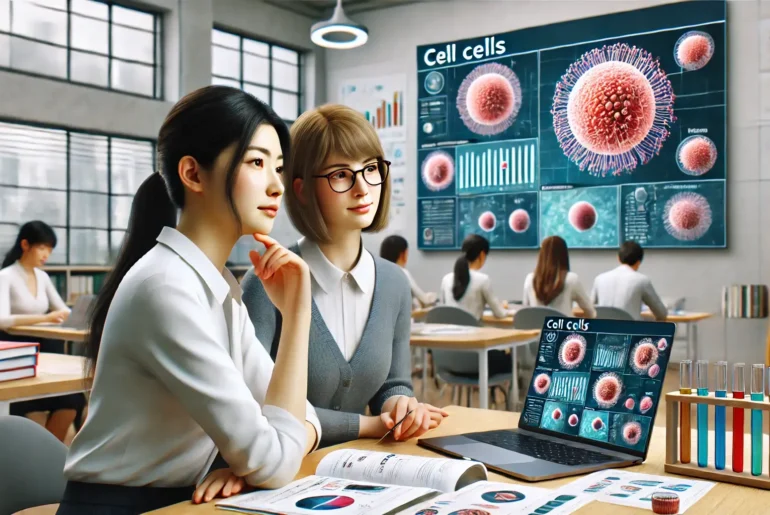Cell Biology Quiz |
Exploring the Complexity of Cells: A Comprehensive Guide
Introduction
Cells are the fundamental units of life, making up every living organism on Earth. Understanding the structure and function of cells is crucial for grasping how life operates at the most basic level. This article complements a challenging quiz on cell biology by delving into the key components and processes that define cellular life. Whether you’re curious about the role of mitochondria, the process of mitosis, or the function of the Golgi apparatus, this guide will help you explore the intricate world of cells.
Mitochondria: The Powerhouses of the Cell
Mitochondria are often referred to as the powerhouses of the cell because they produce ATP, the main energy currency of the cell. This energy production occurs through the process of cellular respiration, where glucose and oxygen are converted into ATP, carbon dioxide, and water.
Example
Imagine mitochondria as the cell’s power plants, generating energy that fuels cellular activities. Cells with high energy demands, like muscle cells, contain numerous mitochondria to meet their energy needs.
Ribosomes: The Protein Factories
Ribosomes are the cellular structures responsible for protein synthesis. They translate messenger RNA (mRNA) into amino acid sequences, forming proteins that perform various functions within the cell.
Example
Ribosomes are like assembly lines in a factory, where workers (the ribosomes) build products (proteins) based on blueprints (mRNA). These proteins are essential for everything from enzyme activity to structural support.
The Cell Membrane: The Gatekeeper
The cell membrane, also known as the plasma membrane, is a selectively permeable barrier that regulates the entry and exit of substances into and out of the cell. This membrane is composed of a lipid bilayer with embedded proteins that facilitate transport and communication.
Example
Think of the cell membrane as a security gate that controls what can enter and leave the cell. It ensures that essential nutrients get in while keeping harmful substances out.
Golgi Apparatus: The Shipping Center
The Golgi apparatus is an organelle that modifies, sorts, and packages proteins and lipids for secretion or delivery to other organelles. It acts as the cell’s shipping center, ensuring that cellular products are correctly processed and sent to their final destinations.
Example
The Golgi apparatus is like a post office that processes and packages parcels (proteins and lipids) before sending them out to their intended destinations within or outside the cell.
Nucleus: The Control Center
The nucleus is the control center of the cell, housing the genetic material (DNA) that directs all cellular activities. It regulates processes such as growth, metabolism, and reproduction, making it essential for the survival of the cell.
Example
The nucleus functions like a command center, where instructions (genes) are stored and issued to direct the cell’s functions and ensure proper operation.
Lysosomes: The Cleanup Crew
Lysosomes are membrane-bound organelles that contain enzymes responsible for breaking down cellular waste, damaged organelles, and foreign invaders. They play a crucial role in maintaining cellular health by recycling materials and preventing the accumulation of waste.
Example
Lysosomes act like the cell’s cleanup crew, digesting and recycling waste to keep the cell clean and functional. Without lysosomes, cells would accumulate harmful debris, leading to dysfunction.
The Cell Cycle: DNA Replication and Cell Division
The cell cycle is a series of phases that cells go through to grow and divide. The S phase of the cell cycle is when DNA replication occurs, ensuring that each daughter cell receives a complete set of genetic information during cell division.
Example
During the S phase, the cell duplicates its DNA, like making a backup copy of important documents. This ensures that when the cell divides, each new cell has an identical set of genetic instructions.
The Cytoskeleton: Structural Support and Movement
The cytoskeleton is a network of protein filaments and tubules that provides structural support for the cell, maintaining its shape and facilitating movement. It also plays a role in intracellular transport and cell division.
Example
The cytoskeleton is like the scaffolding of a building, providing support and shape to the cell. It also acts as a railway system, transporting materials within the cell.
Smooth Endoplasmic Reticulum: Lipid Synthesis and Detoxification
The smooth endoplasmic reticulum (ER) is involved in the synthesis of lipids, metabolism of carbohydrates, and detoxification of drugs and poisons. It plays a critical role in maintaining cellular homeostasis.
Example
The smooth ER is like a chemical processing plant, producing lipids and detoxifying harmful substances to keep the cell functioning properly.
Osmosis: The Movement of Water
Osmosis is the process by which water moves across a selectively permeable membrane from an area of lower solute concentration to an area of higher solute concentration. This process is vital for maintaining cellular hydration and turgor pressure.
Example
Osmosis is like water moving through a filter, balancing the concentration of solutes inside and outside the cell. This process helps plant cells maintain their rigidity and prevents animal cells from shriveling or bursting.
Nucleolus: The Ribosome Producer
The nucleolus is a dense region within the nucleus where ribosomal RNA (rRNA) is synthesized and assembled into ribosomes. These ribosomes then move to the cytoplasm, where they play a key role in protein synthesis.
Example
The nucleolus is like a ribosome factory, producing the components needed to build ribosomes, which are essential for protein production.
Mitosis: Cell Division and Growth
Mitosis is the process of cell division that results in two genetically identical daughter cells. It is essential for growth, tissue repair, and asexual reproduction in multicellular organisms.
Example
Mitosis is like a photocopier, duplicating the cell’s contents so that each new cell has an exact copy of the original cell’s genetic material.
Cellular Respiration: Energy Production in Mitochondria
Cellular respiration is the process by which cells convert glucose and oxygen into ATP, the energy currency of the cell. This process occurs in the mitochondria and is essential for powering cellular activities.
Example
Cellular respiration is like a power plant converting fuel (glucose) into usable energy (ATP) to keep the lights on and machines running in the cell.
Endocytosis: Engulfing Particles
Endocytosis is the process by which cells engulf large particles, such as pathogens or nutrients, by wrapping the cell membrane around them and forming a vesicle. This process allows cells to take in substances that are too large to pass through the membrane by diffusion or active transport.
Example
Endocytosis is like the cell reaching out with its membrane to grab and engulf a large particle, bringing it inside for processing or destruction.
Vacuoles: Storage and Structural Support in Plant Cells
Vacuoles are large, membrane-bound organelles in plant cells that store water, nutrients, and waste products. They also help maintain turgor pressure, providing structural support to keep the plant upright.
Example
The vacuole is like a storage tank that holds water and other materials, keeping the plant cell firm and helping it maintain its structure.
Conclusion
Cell biology is a fascinating field that reveals the intricate processes that sustain life at the microscopic level. By understanding these fundamental concepts, students can gain a deeper appreciation for the complexity and efficiency of cellular functions. Keep exploring, stay curious, and enjoy the journey of discovering how cells work!








Comments are closed.